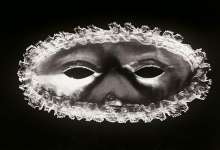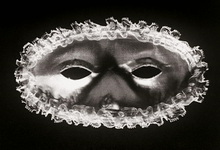- Images (2)
- Liens (0)
- Agenda (0)

|

|

|

|

|
de David WHARRY
1978 / 16mm / n&b / sonore / 1 écran / 7' 25 |
Regardez l'image projetée sur l'écran.
Maintenant, projetez l'image sur l'écran.
Ensuite, imaginez que vos yeux sont fermés, et que vous projetez l'image sur l'écran à travers vos paupières.
Fermez les yeux. Imaginez que vous êtes en train de regarder l'image projetée sur l'écran.
Ouvrez les yeux maintenant. Imaginez que vous êtes en train de regarder l'image projetée sur l'écran.
Phaeton
”When a screen comes in contact with David Wharry`s films, it becomes a photosensitive membrane which, like an "optogram" (an image imprinted on the retina), registers the surrounding action. The screen works, then, as a memory mechanism, a record of Wharry's actions, unveiling the inner-senses of his humorous cinematic charades.? It was in the late seventies that the author created General Picture, a series of episodes built from the rubble of “noir” and mystery films. This body of work is a bright and mysterious plot on the foundations of the moving image. “Phaëton” is one of the few episodes of General Picture that can be viewed independently. In this short film, Wharry makes us focus on the space between the retina and the eyelid to reveal the origin of the image and the birth of otherness.”
Alexandre Estrela, Behind and Beyond the Eyelid.
Willing Suspension of Disbelief
Three films within General Picture, Wishful Thinking, Phaeton and The Screen, can be regarded as a kind of “trilogy”.
They were made over a long time interval (Wishful Thinking, and Phaeton in 1978 and The Screen in 2011), but they form a definite group because they all deal directly with that essential component of the cinema experience, “willing suspension of disbelief”: we have to ignore that we’re viewing a two-dimensional image on a screen and temporarily accept it as reality in order to be entertained.
Because, yes, whether we like it not, cinema is a theatrical experience. By cinema I mean everything: the film itself, the projector, the beam of light, the dark room and of course the audience, the “suspenders of disbelief.”
I worked for a long time as a projectionist, and I always wondered why whenever a film is shown – the same strip of celluloid in the same projector in the same cinema – it’s never the same twice. The simple answer is because we, the audience, are never the same. I mention this because this is another thing Wishful Thinking, Phaeton, The Screen and other films in General Picture have in common: it’s the audience that provides and projects the image, which is therefore always different. The audience is the main accomplice in the theatrical crime.
Wishful Thinking
Making a wish seems to encapsulate everything that cinema is both mechanically and cerebrally: projection.
To make a wish is to perform an act of mental cinema. We form an image on a screen inside our head, visualise something we hope will be realised, materialised, an imaginary prototype of something we want to “come true”.
When we make a wish we often close our eyes to see it better, or to keep it secret behind our eyelids. Can opening our eyes and projecting that wish on a much bigger screen “outside,” in a cinema, make it any realer? Can the blank white movie screen, like unexposed film, be imprinted by the image on our cerebral retina? And can closing our eyes again and projecting the wish through our eyelids onto the screen make it even more real?
Suspension of disbelief: we know it takes more than mental gymnastics to make a wish come true. Wishful Thinking is just a preview screening.
Phaëton
Nothing is invisible in Phaeton, except perhaps the face behind the mask.
A fancy dress mask, an obviously “theatrical” image, an embodiment of “suspension of disbelief,” held in suspension in the darkness by the projector beam.
We can perceive the mask as convex or concave, positive or negative. We can imagine we are inside it looking out or outside looking in. The mask is both inside and out, as much image as non-image, an interface and a mirror, a screen in itself.
Moulding the face around the eyes, the mask “acts” as a disembodied, theatrically disguised mirror of the audience, a “projection” of the illusionist/projectionist viewer.
The Screen
The actors: a projector, a screen, a voice, an audience and a cinema.
The locations: “here” and “there”.
The situation: an audience is sitting in the dark in a cinema.
The film begins when the projector is switched on.
The projector is running empty, projecting only a bright white rectangle on the screen.
The action begins when the voice asks the audience: “Are you there?”
“Yes, you’re there,” the voice replies for us. “But one day you won’t be there, will you?”
The voice isn’t “there.” Where is it? “Here.” Where? On the other side of the screen.
The voice then asks us to project ourselves into a scenario, into the film of that inevitable eventuality we all prefer not to think about: the passage from one side of the screen to the other, from being “there” to “no longer being there,” from “here” to “there.”
And what better place to do this than in a cinema?
Phaeton, Wishful Thinking and The Screen deal with the core theatrical reflexes. The Screen takes them into the (invisible) narrative domain, aspects of which are then explored in other films in General Picture such as Freighters of Destiny, A Plate Couture, El Cafetal, Written on the Wind and Point Blank.
David Wharry
| format de distribution | 16mm |
|---|---|
| cadre de projection | 1,37 (simple écran) |
| vitesse de projection | 24 ips |
| son | son magnétique |
| traduction | français (Voix-off) |
| prix de location | 41,00 € |
| format de distribution | 16mm |
|---|---|
| cadre de projection | 1,37 (simple écran) |
| vitesse de projection | 24 ips |
| son | son optique |
| traduction | anglais (Voix-off) |
| prix de location | 41,00 € |
| format de distribution | Fichier sur serveur (FHD) |
|---|---|
| cadre de projection | 1,37 (simple écran) |
| vitesse de projection | 24 ips |
| son | son |
| traduction | anglais (Voix-off) |
| prix de location | 41,00 € |
| format de distribution | DCP sur serveur (SMPTE 2K) |
|---|---|
| cadre de projection | 1,37 (simple écran) |
| vitesse de projection | 24 ips |
| son | son |
| traduction | anglais (Voix-off) |
| prix de location | 41,00 € |